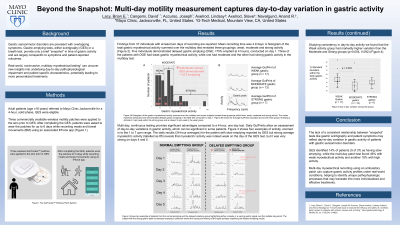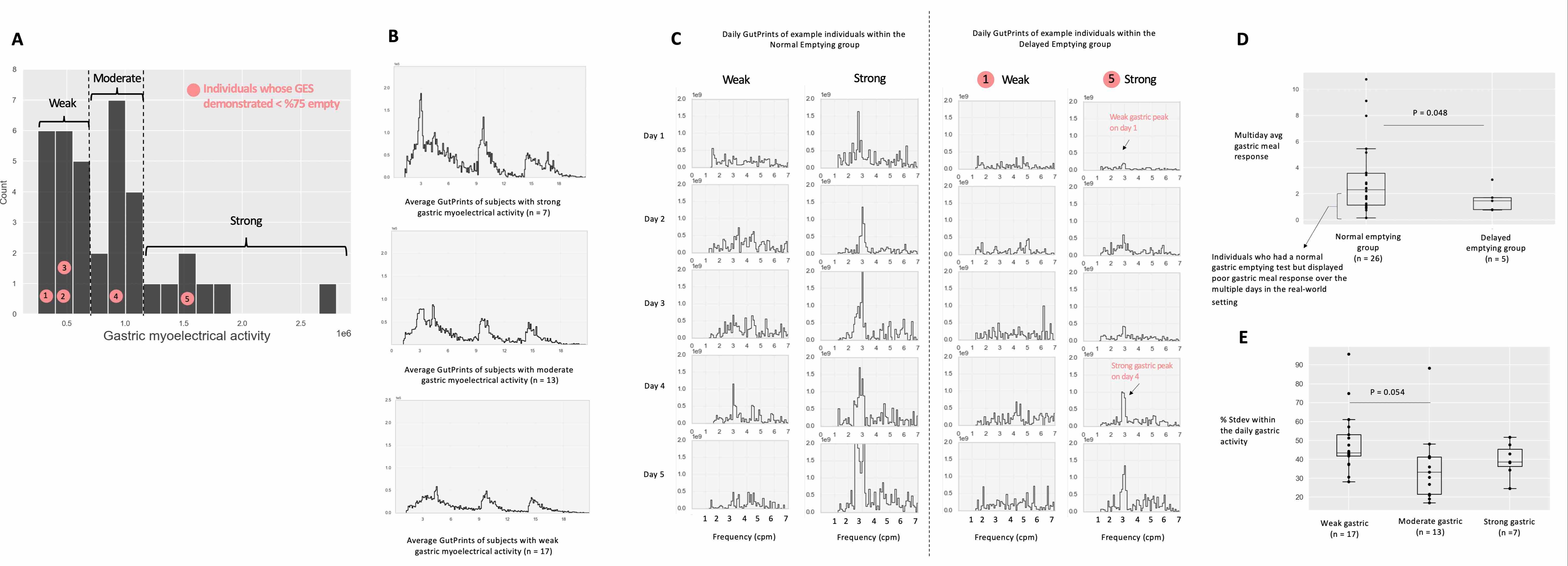Sunday Poster Session
Category: Stomach
P1620 - Beyond the Snapshot: Multi-Day Motility Measurement Captures Day-to-Day Variation in Gastric Activity
Sunday, October 27, 2024
3:30 PM - 7:00 PM ET
Location: Exhibit Hall E

- BL
Brian E. Lacy, MD, PhD, FACG
Mayo Clinic
Jacksonville, FL
Presenting Author(s)
Award: Presidential Poster Award
Brian E. Lacy, MD, PhD, FACG1, David J. Cangemi, MD1, Joseph Accurso, BS, MD1, Lindsay Axelrod, MS2, Steve Axelrod, PhD2, Anand Navalgund, PhD2
1Mayo Clinic, Jacksonville, FL; 2G-Tech Medical, Mountain View, CA
Introduction: Gastric sensorimotor disorders are prevalent with often overlapping symptoms. Gastric emptying tests, either scintigraphy (GES) or a breath test, provide only a brief “snapshot” of gastric myoelectrical activity and are largely nonspecific to symptoms and patient-reported outcomes. Real-world, noninvasive multiday testing can uncover new insights into underlying day-to-day pathophysiological impairment and patient specific characteristics, potentially leading to more personalized treatments.
Methods: Adult patients referred to the nuclear medicine department at Mayo Clinic Jacksonville for a 4-hour, solid phase, scintigraphic gastric emptying scan (GES) were eligible for study inclusion. Three wireless motility patches were applied to the skin; patients were instructed to wear the patches for 6 days while recording mealtimes and bowel movements using an iPhone app.
Results: Findings from 37 individuals with at least two days of recording are reported. Mean recording time was 4.9 days. Histograms of the frequencies of gastric myoelectrical activity summed over the multiday test revealed three groupings: weak, moderate and strong activity (Fig 1A). The average histograms (Fig 1B) calculated across the three groups revealed a dominant 3 cpm peak within the strong group which was absent in the weak group. Five individuals demonstrated delayed gastric emptying (DGE) of < 75% at 4 hours in the GES test, conducted on day 1. Three of the patients with DGE had weak gastric myoelectrical activity, while one had moderate and the other had strong gastric activity in the multiday test. However, a daily GutPrint for the high activity patient (Fig1C) reveals both weak and strong days with a weak peak on the day of the GES test. Meal responses (Fig 1D) were averaged over the multiday test and revealed weaker meal response (p=0.048) within the DGE group. The weak activity group (Fig 1E) had markedly higher variation in day-to-day activity than the other groups (p=0.054, 0.092).
Discussion: The lack of consistent relationship between “snapshot” tests like gastric scintigraphy and patient symptoms may reflect variation in gut myoelectrical activity of patients with gastric sensorimotor disorders on a day-to-day basis. Prolonged ambulatory recording of gastrointestinal activity using a wireless motility patch can capture gastric activity profiles under real-world conditions, helping to identify unique pathophysiologic processes that may translate into more individualized and effective treatments.

Disclosures:
Brian E. Lacy, MD, PhD, FACG1, David J. Cangemi, MD1, Joseph Accurso, BS, MD1, Lindsay Axelrod, MS2, Steve Axelrod, PhD2, Anand Navalgund, PhD2. P1620 - Beyond the Snapshot: Multi-Day Motility Measurement Captures Day-to-Day Variation in Gastric Activity, ACG 2024 Annual Scientific Meeting Abstracts. Philadelphia, PA: American College of Gastroenterology.
Brian E. Lacy, MD, PhD, FACG1, David J. Cangemi, MD1, Joseph Accurso, BS, MD1, Lindsay Axelrod, MS2, Steve Axelrod, PhD2, Anand Navalgund, PhD2
1Mayo Clinic, Jacksonville, FL; 2G-Tech Medical, Mountain View, CA
Introduction: Gastric sensorimotor disorders are prevalent with often overlapping symptoms. Gastric emptying tests, either scintigraphy (GES) or a breath test, provide only a brief “snapshot” of gastric myoelectrical activity and are largely nonspecific to symptoms and patient-reported outcomes. Real-world, noninvasive multiday testing can uncover new insights into underlying day-to-day pathophysiological impairment and patient specific characteristics, potentially leading to more personalized treatments.
Methods: Adult patients referred to the nuclear medicine department at Mayo Clinic Jacksonville for a 4-hour, solid phase, scintigraphic gastric emptying scan (GES) were eligible for study inclusion. Three wireless motility patches were applied to the skin; patients were instructed to wear the patches for 6 days while recording mealtimes and bowel movements using an iPhone app.
Results: Findings from 37 individuals with at least two days of recording are reported. Mean recording time was 4.9 days. Histograms of the frequencies of gastric myoelectrical activity summed over the multiday test revealed three groupings: weak, moderate and strong activity (Fig 1A). The average histograms (Fig 1B) calculated across the three groups revealed a dominant 3 cpm peak within the strong group which was absent in the weak group. Five individuals demonstrated delayed gastric emptying (DGE) of < 75% at 4 hours in the GES test, conducted on day 1. Three of the patients with DGE had weak gastric myoelectrical activity, while one had moderate and the other had strong gastric activity in the multiday test. However, a daily GutPrint for the high activity patient (Fig1C) reveals both weak and strong days with a weak peak on the day of the GES test. Meal responses (Fig 1D) were averaged over the multiday test and revealed weaker meal response (p=0.048) within the DGE group. The weak activity group (Fig 1E) had markedly higher variation in day-to-day activity than the other groups (p=0.054, 0.092).
Discussion: The lack of consistent relationship between “snapshot” tests like gastric scintigraphy and patient symptoms may reflect variation in gut myoelectrical activity of patients with gastric sensorimotor disorders on a day-to-day basis. Prolonged ambulatory recording of gastrointestinal activity using a wireless motility patch can capture gastric activity profiles under real-world conditions, helping to identify unique pathophysiologic processes that may translate into more individualized and effective treatments.

Figure: Figure 1A. Histogram of gastric myoelectrical activity summed over the multiday test across subjects reveals three distinct groupings - weak, moderate and strong activity. The circles represent individuals who demonstrated delayed gastric emptying in the GES test conducted on Day 1. Figure 1B shows the average GutPrints calculated across the three groups revealing a dominant 3 cpm peak within the strong group and an absent 3 cpm peak in the weak group. Figure 1c shows two example patients from the normal emptying and the delayed emptying group highlighting either a steady or a varying gastric signal over the multiple day period. The subject with the strong gastric peak but delayed emptying in particular shows the waxing and waning of the signal perhaps explaining the delayed emptying results. Figure 1D shows the gastric meal response averaged over the multiple days. While individuals with delayed gastric emptying had lower gastric meal response, there were many individuals with normal emptying that also had a lower gastric meal response. Figure 1E shows the % stnd. Dev. within the daily gastric activity for each individual subject within the weak, moderate and strong group.
Disclosures:
Brian Lacy: AbbVie – Consultant. Ardelyx – Consultant. Gemelli Biotech – Consultant. Ironwood Pharmaceuticals – Consultant. Salix Pharmaceuticals – Consultant. Takeda – Consultant.
David Cangemi indicated no relevant financial relationships.
Joseph Accurso indicated no relevant financial relationships.
Lindsay Axelrod: G-Tech Medical – Employee.
Steve Axelrod: G-Tech Medical – Employee.
Anand Navalgund: G-Tech Medical – Employee.
Brian E. Lacy, MD, PhD, FACG1, David J. Cangemi, MD1, Joseph Accurso, BS, MD1, Lindsay Axelrod, MS2, Steve Axelrod, PhD2, Anand Navalgund, PhD2. P1620 - Beyond the Snapshot: Multi-Day Motility Measurement Captures Day-to-Day Variation in Gastric Activity, ACG 2024 Annual Scientific Meeting Abstracts. Philadelphia, PA: American College of Gastroenterology.

